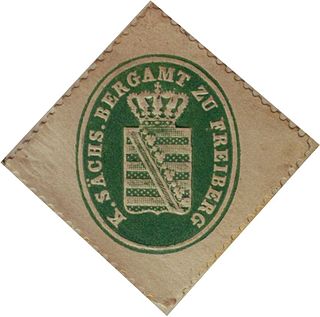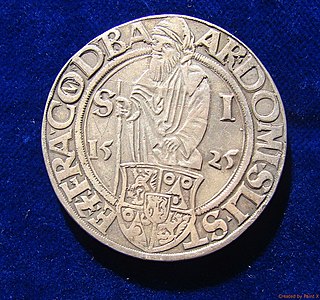
The Upper Harz Water Regale is a system of dams, reservoirs, ditches and other structures, much of which was built from the 16th to 19th centuries to divert and store the water that drove the water wheels of the mines in the Upper Harz region of Germany. The term regale, here, refers to the granting of royal privileges or rights in this case to permit the use of water for mining operations in the Harz mountains of Germany.
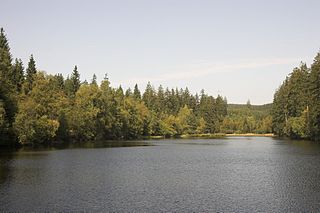
The Silberteich is a man-made reservoir, of a type called a Kunstteich, and lies on the upper reaches of the Brunnenbach stream between Braunlage and Sankt Andreasberg in the Harz Mountains of Germany. It was built as part of the historic Upper Harz Water Regale.
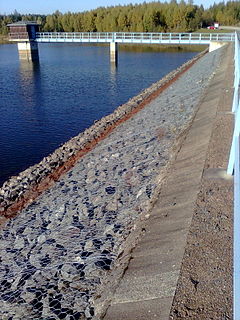
The Kiliansteich is one of the oldest reservoirs in Germany. The reservoir is located near Straßberg (Harz) in the German state of Saxony-Anhalt and supplies drinking water. It impounds the Büschengraben stream. The lake is part of the heritage area (Flächendenkmal) of the Lower Harz Pond and Ditch System.
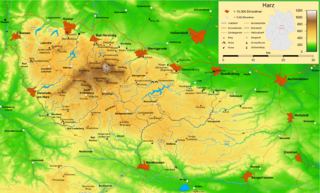
Within the Lower Harz region are still many traces of the historical water management facilities used by the mining industry. In addition to water-carrying ditches and ponds, there are also long-abandoned ditches and dry pond beds. The Lower Harz Pond and Ditch System, which forms the major part of these old water management facilities, lies in the central Lower Harz, almost entirely within the borough of the present-day town of Harzgerode.

The Glasebacher Teich was an artificial reservoir or Kunstteich laid out near the village of Straßberg in the Harz Mountains of Germany for mining purposes. With a capacity of about 300,000 m³ it was the second largest pond in the Lower Harz. It impounded the Glasebach stream.
The Frankenteich is an old reservoir in the Harz Mountains of central Germany. It was constructed in 1716 under the direction of mining director (Bergwerksdirektor), Christian Zacharias Koch, for the mining industry and is the largest pond in the Lower Harz. Since 1901 it has supplied drinking water to the village of Straßberg. It impounds the Rödelbachgraben, which discharges into the Selke in Straßberg. A mining ditch runs past the foot of the dam from the Kiliansteich which, like the Frankenteich, belongs to the heritage area designated as the Lower Harz Pond and Ditch System.
The Siebengründer Graben is a mining ditch that was constructed in 1903/1904 in the Lower Harz in central Germany. Today, it is dry.

The Hüttenstollen, also Straßberger Hüttenstollen, was the central drainage adit in the Straßberg mining field and was also part of the Lower Harz Pond and Ditch System in the Harz Mountains of Germany. The adit lies at a depth of 50 m and is 750 m long. The pit water was drained into the Selke. The drainage ditches were the Straßberger Flösse and the Stollgraben.
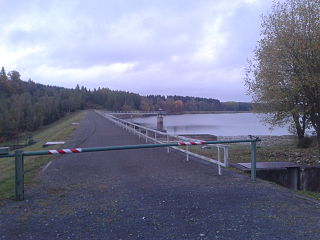
The Teufelsteich was one of the oldest reservoirs in the Harz Mountains of central Germany.

The Neugrabenflöße, was a roughly 18 km long Kunstgraben dating to the 17th century. It enabled the rafting of timber for the mining and smelting industries in the Ore Mountains of eastern Germany. It ran from the River Flöha near Fleyh (Fláje) to the Freiberger Mulde near Clausnitz in the Ore Mountains.

The Graben Tour is a mining history footpath in the north of the former district of Freiberg in the German Free State of Saxony. It follows the course of an old mining water channel, in the valley of the Bobritzsch, from Krummenhennersdorf to Reinsberg.

The Bergrat Müller Pond, named after a former mining director, Müller, in the Harz mountains of central Germany is a storage pond laid out from 1737 to 1738. It has an area of about 1.3 ha and lies in the forested southern part of the borough of Quedlinburg in the county of Harz in Saxony-Anhalt.
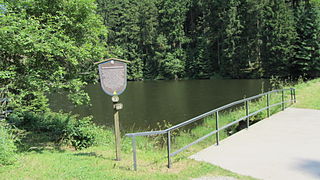
The Lower Grumbach Pond, usually just Grumbach Pond, is an old mining reservoir or Kunstteich between Hahnenklee and Wildemann in the Upper Harz mountains in Germany

Siebenlehn is a district of the town Großschirma in Landkreis Mittelsachsen. Until 2003 it was a separate town. Upon fusion with the neighbouring rural municipality Großschirma on 1 September 2003, the town privileges were transferred to the joint municipality.




